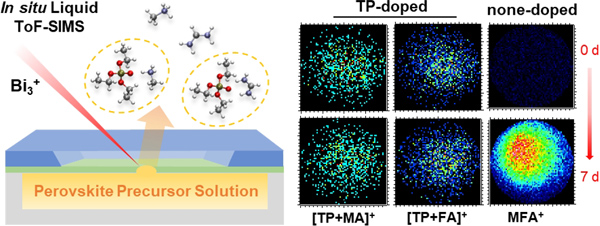Researchers Uncover Aging Chemistry of Perovskite Precursor Solutions
Metal halide perovskite solar cells (PSCs) have gained tremendous attention as they possess excellent optoelectronic properties including controllable band gap and long charge carrier diffusion length and their power conversion efficiency (PCE) has rapidly advanced from the initial 3.8% to over 25% during the past decade. However, one major stumbling block for the commercialization of PSCs is the chemical instability of species in precursor solutions under ambient conditions, which causes the solution aging and as a consequence reduces the quality and reproducibility of the resulting PSCs. To date, little efforts have been dedicated to providing deep understanding of the aging process of perovskite precursor solutions, and no direct experimental evidences were available for uncovering the exact anti-aging mechanisms of additives in the solutions.
Recently, a joint research team led by Prof. WANG Fuyi at the Institute of Chemistry, Chinese Academy of Sciences (ICCAS) and Prof. CHEN Yiwang/ Prof. HU Xiaotian at Nanchang University used the state-of-the-art in situ liquid time-of-flight secondary ion mass spectrometry (ToF-SIMS) to molecularly explore the chemistry of a typical triple-cation mixed halide perovskite precursor solution. They discovered that the methylammonium (MA+) and formamidinium (FA+) cations and the I- anion are the motivators of the aging chemistry. Further, they introduced two kinds of Lewis bases, triethyl phosphate (TP) and ethyl ethanesulfonate (EE), as new additives in the solution and unraveled that both of the additives can protect the reactive cations from aging through weak interactions. Significantly, TP is superior to EE in enhancing long-term solution stability as it can well-maintain the internal interaction structures within the solution phase. They collaborated with Dr. NI Zhigang at Hangzhou Normal University and applied density functional theory (DFT) calculations to theoretically verify the mechanism of action of anti-aging additives. The PSC derived from a fresh TP-doped solution delivered a high power conversion efficiency of 23.06%, 92.23% of which remained in that from a 21-day-old solution.
This work is supported by the National Natural Science Foundation of China. This research progress was recently published in Angew. Chem. Int. Ed., 2023, 62, e202215799, entitled “Uncovering Aging Chemistry of Perovskite Precursor Solutions and Anti-aging Mechanism of Additives”.

In situ analysis of the aging chemistry and anti-aging mechanism of perovskite solution using in situ liquid ToF-SIMS. (Image by Prf. WANG)
Contact:
Prof. WANG Fuyi, Associate Prof. ZHANG Yanyan
Institute of Chemistry, Chinese Academy of Sciences
Email: fuyi.wang@iccas.ac.cn, zhangyy0816@iccas.ac.cn





